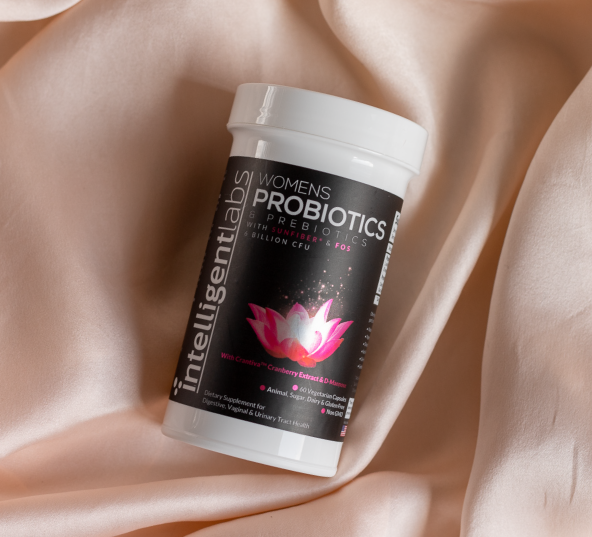Probiotics
Can Probiotics Help Prevent Urinary Tract Infections (UTIs)?
Urinary tract infections (UTIs) can be both painful and disruptive, causing frequent, uncomfortable trips to the bathroom. For those seeking a natural approach to managing symptoms, probiotics for UTIs may offer a promising solution.
Although antibiotics are a common treatment for these infections, they come with several drawbacks. Read on to find out why our Women’s Probiotics may be the best natural solution for managing UTIs.
Table of Contents
What are urinary tract infections (UTIs)?
UTIs are bacterial infections that can affect any part of the urinary system, from the urethra to the kidneys. The most common cause is the bacteria known as Escherichia coli (E. coli), which normally resides harmlessly in the gut but can cause infections when it spreads to the urinary tract.
UTI symptoms include pain during urination, frequent or urgent urination, nocturia (nighttime urination), unusual urine color, and abdominal or lower back pain.
Women are particularly prone to UTIs due to their shorter urethras, with over 50% experiencing at least one UTI in their lifetime, and 25%-50% suffering from recurrent infections. If not treated promptly, UTIs can escalate, spreading to the kidneys and leading to more severe complications. 1
What’s the problem with current UTI treatment options?
The go-to treatment for UTIs has long been a course of antibiotics, which remains effective for uncomplicated cases. However, there are growing concerns:
- Antibiotic resistance: Increasingly, the bacteria causing UTIs are becoming resistant to antibiotics. 2
- Negative impact on health: Antibiotics not only target the bacteria causing the infection but also eliminate beneficial gut bacteria. This disruption can lead to an imbalance known as ‘dysbiosis.’ 3
Dysbiosis can cause an overgrowth of harmful microbes, leading to conditions like fungal infections, including thrush and candida overgrowth, as well as gastrointestinal infections. Long-term, it has also been associated with skin issues, mental health problems like anxiety and depression, immune dysfunctions, and obesity. 4
How to treat UTIs without using antibiotics?
So, because of the problems with antibiotic treatment and the increase of antibiotic-resistant strains of bacteria, this form of treatment is becoming less and less effective. Going forward, UTI prevention is a significant treatment goal, especially for those who suffer from recurrent infections.

Now, there are 3 major areas we can focus on to help prevent – and treat – UTIs.
Step 1: Take care of your hygiene to prevent UTIs
Key practices include urinating when needed, wiping from front to back (for ladies), showering instead of bathing, and cleansing the genital area before and after sexual activity. Also, avoid irritants like feminine sprays and douching, which disrupt the natural microbial balance.
Step 2: Take probiotics to prevent urinary tract infections
Adding probiotics into daily routines can be a powerful way to prevent UTIs by ensuring a balanced bacterial environment in the gut and vaginal areas.
Probiotics, often referred to as ‘good bacteria,’ naturally inhabit our gut, helping maintain a healthy balance and keeping pathogenic bacteria like E. coli in check.
For those susceptible to UTIs, particularly women, probiotic capsules may be particularly beneficial. These supplements not only restore the normal flora in the gut but are also helpful for maintaining the health of the vaginal microbiome, which directly influences UTI vulnerability. 5
Fermented foods such as yogurt, miso, sauerkraut, and kefir are excellent sources of probiotics. Yet, for targeted UTI prevention, probiotic capsules specifically designed to enhance the Lactobacillus populations in the vagina are more effective. 6 7
Step 3: Take cranberry juice and D-mannose powder
Cranberry juice has been traditionally recognized for its role in preventing UTIs, primarily through compounds like proanthocyanidin (PAC) and D-mannose. The mechanism through which these compounds work involves blocking the sticky ends of the bacteria’s fimbriae, preventing them from attaching to and infecting the urinary tract walls. 8
While cranberry juice provides a modest amount of these beneficial compounds, taking D-mannose in powder form offers a more potent intervention. This simple sugar effectively interferes with bacterial adhesion, greatly reducing the likelihood of UTI development. 9
D-mannose’s efficacy and safety, including its non-disruptive impact on blood sugar levels, make it a recommended supplement for long-term UTI prevention in both non-diabetic and diabetic individuals. 10
The winning formula for UTI prevention: Probiotics + Cranberry + D-mannose
Probiotics, cranberry juice powder, and pure D-mannose powder have all shown their effectiveness in reducing UTIs. Multiple studies show that cranberry juice powder and D-mannose may be more effective at preventing UTIs than antibiotics.11 12 Moreover, probiotics have many health benefits outside of preventing UTIs and are a vital part of any health regimen.

Now, is there such a product that combines ALL THREE UTI-fighting ingredients – probiotics, cranberry juice powder, and D-mannose powder?
Yes, there is! Here at Intelligent Labs, we’ve combined patented probiotic strains, cranberry juice powder, and D-mannose in our Women’s Probiotics! This supplement is formulated not only to help prevent UTIs but also to maximize mental and physical health.
Moreover, each capsule of our Women’s Probiotics also contains the prebiotics Sunfiber® & FOS. Prebiotics are non-digestible fibers that act as food for probiotics. These fibers essentially nourish the probiotics when they are in the capsule and in your gut. This helps ensure the probiotics are still alive when you take them and successfully reproduce in the gut.
Then finally, we use an Activ-Polymer™ bottle, which features an impenetrable desiccant sleeve wrapped around the probiotic to ensure they are virtually moisture-free. The Oxyfree® desiccant absorbs any oxygen and removes any residual moisture from inside the bottle. This is because probiotics will degrade whenever they are exposed to moisture and oxygen, and we do our utmost to ensure the probiotics reach you in perfect condition.
Conclusion
Choosing natural ways to prevent and treat urinary tract infections can lead to better health and less reliance on antibiotics. With our Women’s Probiotics, you get a comprehensive daily supplement that can strengthen your body’s ability to fight off UTIs!
💬 Something on your mind? Share your thoughts in the comments. We love hearing from curious minds.
📩 And while you’re here, join our newsletter for more smart stuff (and secret perks)!
References:
- Czajkowski, Krzysztof et al. “Urinary tract infection in women.” Przeglad menopauzalny = Menopause review vol. 20,1 (2021): 40-47. doi:10.5114/pm.2021.105382 ↩︎
- Mortazavi-Tabatabaei, Seyed Abdol Reza et al. “Pattern of Antibacterial Resistance in Urinary Tract Infections: A Systematic Review and Meta-analysis.” International journal of preventive medicine vol. 10 169. 9 Oct. 2019, doi:10.4103/ijpvm.IJPVM_419_17 ↩︎
- Ruța, Florina et al. “Associations between Gut Microbiota Dysbiosis and Other Risk Factors in Women with a History of Urinary Tract Infections.” Nutrients vol. 16,11 1753. 3 Jun. 2024, doi:10.3390/nu16111753 ↩︎
- Duvallet, Claire et al. “Meta-analysis of gut microbiome studies identifies disease-specific and shared responses.” Nature communications vol. 8,1 1784. 5 Dec. 2017, doi:10.1038/s41467-017-01973-8 ↩︎
- Akgül, Turgay, and Tolga Karakan. “The role of probiotics in women with recurrent urinary tract infections.” Turkish journal of urology vol. 44,5 (2018): 377-383. doi:10.5152/tud.2018.48742 ↩︎
- Cribby, Sarah et al. “Vaginal microbiota and the use of probiotics.” Interdisciplinary perspectives on infectious diseases vol. 2008 (2008): 256490. doi:10.1155/2008/256490 ↩︎
- Anukam, Kingsley et al. “Augmentation of antimicrobial metronidazole therapy of bacterial vaginosis with oral probiotic Lactobacillus rhamnosus GR-1 and Lactobacillus reuteri RC-14: randomized, double-blind, placebo controlled trial.” Microbes and infection vol. 8,6 (2006): 1450-4. doi:10.1016/j.micinf.2006.01.003 ↩︎
- González de Llano, Dolores et al. “Cranberry Polyphenols and Prevention against Urinary Tract Infections: Relevant Considerations.” Molecules (Basel, Switzerland) vol. 25,15 3523. 1 Aug. 2020, doi:10.3390/molecules25153523 ↩︎
- Rădulescu, Daniela et al. “Combination of cranberry extract and D-mannose – possible enhancer of uropathogen sensitivity to antibiotics in acute therapy of urinary tract infections: Results of a pilot study.” Experimental and therapeutic medicine vol. 20,4 (2020): 3399-3406. doi:10.3892/etm.2020.8970 ↩︎
- D-Mannose for Bladder and Kidney Infections by Jonathan Wright, MD, Editor, Nutrition and Healing, Tahoma Clinic Blog, D-Mannose for Bladder and Kidney Infections ↩︎
- Murina, Filippo et al. “Efficacy of an orally administered combination of Lactobacillus paracasei LC11, cranberry and D-mannose for the prevention of uncomplicated, recurrent urinary tract infections in women.” Urologia vol. 88,1 (2021): 64-68. doi:10.1177/0391560320957483 ↩︎
- Vicariotto, Franco. “Effectiveness of an association of a cranberry dry extract, D-mannose, and the two microorganisms Lactobacillus plantarum LP01 and Lactobacillus paracasei LPC09 in women affected by cystitis: a pilot study.” Journal of clinical gastroenterology vol. 48 Suppl 1 (2014): S96-101. doi:10.1097/MCG.0000000000000224 ↩︎





